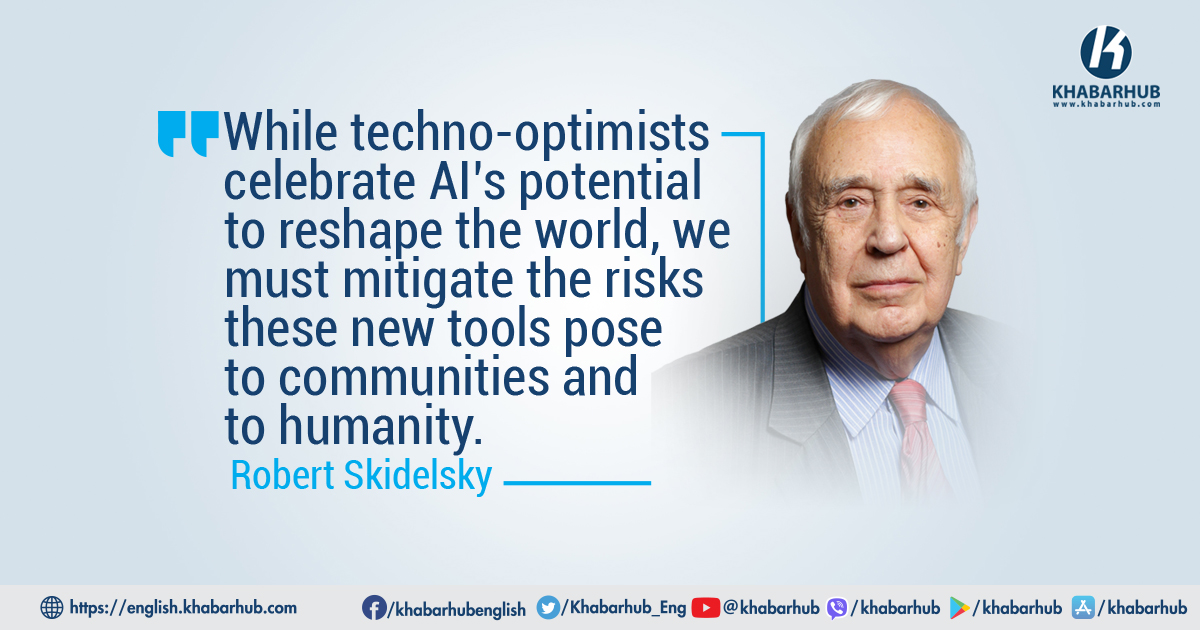A little over a year ago, the San Francisco-based OpenAI released its chatbot, ChatGPT, triggering an artificial-intelligence gold rush and reigniting the age-old debate about the effects of automation on human welfare.
The fear of displacement by machines can be traced back to the nineteenth-century Industrial Revolution, when groups of English handloom weavers, known as Luddites, began destroying the power looms that threatened their livelihoods.
The movement, which peaked between 1811 and 1817, was ultimately suppressed by government forces, and its leaders were executed or exiled to Australia.
But the Luddites’ arguments found an unexpected (and somewhat ironic) champion in renowned economist David Ricardo, who argued in his 1817 book On the Principles of Political Economy and Taxation that “the opinion entertained by the laboring class, that the employment of machinery is frequently detrimental to their interests, is not founded on prejudice and error, but is conformable to the correct principles of political economy.”
The British economist Nassau Senior, for his part, advised the weavers to “get out of that branch of production.”
They ended up doing just that: 250,000 handloom jobs disappeared between 1820 and 1860.
But while mechanization ended up benefiting human workers – the United Kingdom’s population and per capita real income multiplied over the same period – it adversely affected horses, whose numbers fell sharply as trains (and, later, motorized vehicles) replaced horse-drawn transport.
As experts and scholars grow increasingly concerned about AI’s capacity to destroy the world, a growing number of voices have called for AI development to be aligned with human goals and values.
Since the Industrial Revolution, the prevailing pro-machine argument has been that by increasing labor productivity, automation boosts real incomes, allowing more individuals to enjoy higher living standards without corresponding job losses.
Moreover, liberation from tedious menial tasks has enabled us to redirect our energy to more valuable pursuits.
The Luddites’ modern-day counterparts, on the other hand, emphasize the downsides of automation, especially the potential to destroy livelihoods and communities.
An equitable distribution of income and power, they argue, is crucial to reaping the long-term benefits of technological progress.
Techno-pessimists like Martin Ford and Daniel Susskind have argued that emerging technologies like AI will create too few new jobs, resulting in increased poverty and “technological unemployment.”
The rise of generative AI and the anticipated arrival of artificial general intelligence – an AI capable of any cognitive task that humans can perform – have supercharged the debate between techno-optimists and techno-skeptics.
For example, in the health-care sector, a seemingly endless wellspring of tech hype, AI promises improved diagnostics, advanced telemedicine, more effective drugs, and reduced administrative burdens on doctors and nurses, leaving more time for patient care.
This seems to reflect the prevailing view among mainstream experts that generative AI will augment, rather than replace, human jobs.
By automating routine tasks, it promises to free humans to pursue more creative work.
To be sure, this transformation will require lifelong learning, making continuous education a condition not just for participating in the job market but also for accessing an expanding array of online services.
With the advent of generative AI, concerns have shifted from automation-induced job losses to the prospect of a superintelligence going rogue – a fear that dates back to Mary Shelley’s 1818 novel Frankenstein; or, The Modern Prometheus.
With rapid commercialization apparently taking precedence over caution, and competition hastening the development of increasingly powerful tools, an AI-induced apocalypse seems increasingly plausible.
Echoing these sentiments, former Google CEO Eric Schmidt recently remarked that while current AI models remain “under human control,” there is a real risk that one could develop the capability for “recursive self-improvement,” gain autonomy, and begin “setting its own goals.”
Eventually, he warned, a “computer cluster” could evolve into a “truly superhuman expert” capable of acting independently.
As experts and scholars grow increasingly concerned about AI’s capacity to destroy the world, a growing number of voices have called for AI development to be aligned with human goals and values.
There are two ways to achieve this. The first is to restrict the availability and sales of potentially harmful AI-based products, as policymakers in Europe and elsewhere have tried to do by imposing strict regulations on emerging technologies like autonomous cars and facial recognition.
One obvious problem with this approach is that reaching a consensus on what constitutes harm is difficult in a world in which moral relativism is the norm.
Since it is increasingly unclear who “owns” content that is deemed harmful, it is virtually impossible to hold vendors or providers accountable.
Moreover, attempts to regulate the use of technology tend to come too late.
The second way to rein in AI is to limit altogether the development of potentially dangerous products.
And in today’s political economy, “technological innovation” is often a euphemism for enabling the rich and powerful to redirect capital from industry to finance, thereby monopolizing the benefits of automation and immiserating everyone else.
But curbing demand is more complicated than restricting supply, especially in modern societies where competitive forces – both commercial and geopolitical – make slowing down technological innovation exceedingly difficult.
The recent turmoil at OpenAI is a case in point. In November, the company’s board of directors briefly fired CEO Sam Altman, reportedly due to concerns that AI could one day lead to humanity’s extinction.
Although Altman was reinstated just days later, the scandal underscored the speed with which ostensibly beneficial technologies could become existential risks.
With rapid commercialization apparently taking precedence over caution, and competition hastening the development of increasingly powerful tools, an AI-induced apocalypse seems increasingly plausible.
The inescapable conclusion is that merely regulating AI is not enough.
But by introducing concepts such as neo-Luddism and redistribution into the public debate, we could develop the political and intellectual vocabulary needed to mitigate the threats posed by these emerging technologies.
For example, a neo-Luddite might ask: Why are affluent societies, which already produce more than enough for their citizens to live comfortably, still focused on maximizing GDP growth?
One answer might be the lack of a fair distribution of wealth and income that would ensure that the benefits of productivity and efficiency gains are widely shared.
Another explanation is that technology itself is not intrinsically good or bad; it is a means to an end.
And in today’s political economy, “technological innovation” is often a euphemism for enabling the rich and powerful to redirect capital from industry to finance, thereby monopolizing the benefits of automation and immiserating everyone else.
(Robert Skidelsky is a member of the British House of Lords and Professor Emeritus of Political Economy at Warwick University)
Copyright: Project Syndicate








Comment